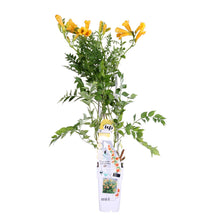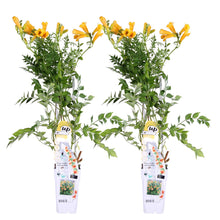Campsis radicans 'Flava', also known as the Golden Trumpet Vine or Yellow Trumpet Creeper, is a vigorous and eye-catching deciduous climber prized for its profusion of large, trumpet-shaped, golden-yellow flowers. This cultivar of Campsis radicans produces masses of these showy blooms throughout the summer months, creating a vibrant and cheerful display. The flowers are a magnet for pollinators, especially hummingbirds. It's a popular choice for covering walls, fences, and arbors, adding a bold splash of sunshine yellow to gardens and outdoor spaces. It belongs to the Bignoniaceae family.
Origin: The species Campsis radicans is native to the eastern United States. 'Flava' is a cultivar specifically selected for its golden-yellow flower colour.
Light: This trumpet vine thrives in full sun, requiring at least 6-8 hours of direct sunlight per day to achieve its best flowering potential.
Water: Regular watering is important, especially during dry periods and in the first year after planting. While it prefers consistently moist soil, it's crucial to avoid overwatering, which can lead to root rot.
Soil: Campsis radicans 'Flava' is adaptable and can grow in a variety of soils, but it prefers well-drained, fertile soil.
Support: Due to its vigorous climbing nature, this plant needs strong support. Provide a sturdy trellis, fence, or wires to allow it to climb. It also has aerial rootlets that can cling to surfaces, aiding its ascent.
Pruning: Pruning helps manage the size and shape of the vine. It's best to prune in late winter or early spring, removing any dead or damaged growth and shaping it as desired.
Hardiness: This cultivar is hardy and can withstand cold winters.
Uses: Campsis radicans 'Flava' is primarily grown as an ornamental climber for its striking flowers and its ability to attract pollinators. Its vibrant blooms make it a popular choice for adding a splash of colour to gardens and outdoor spaces.
Toxicity: While generally not considered highly toxic, this plant can cause mild to moderate toxicity in humans and pets. The sap may cause skin irritation, and ingesting any part of the plant can lead to gastrointestinal upset. It's advisable to handle this plant with care, wearing gloves during pruning, and to keep it out of reach of children and pets.



